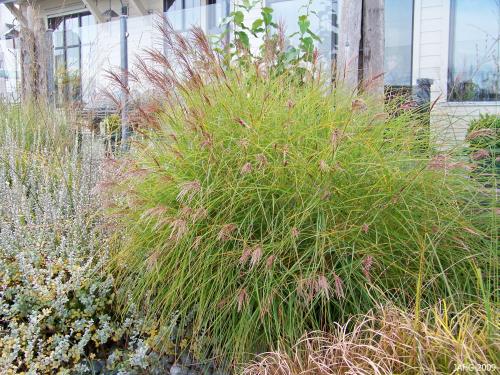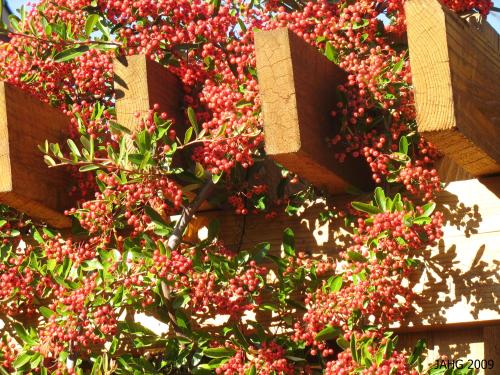We are now on the edge of what I call ‘change over season’ which is when we move from the summer season of warm dry weather to the cool wet winter. This time of the late year is when big storms start to roll in dumping vast amounts of rain along with heavy winds. Now until the start of December is when we have power outages and roads blocked by tree limbs falling across them. The trees which were glorious in their fall coat of colorful leaves are suddenly bear from the repeated gusting of wind and punishing rains. The sounds of creaking tree limbs, rumblings of the tides and sometimes distant thunder make us want to bundle up warmly. This is the time of the year where our gardens start to become skeletons of their former vibrant selves, only the backbones are left. One of the best bones left in the garden here is Miscanthus as it does stand up well with the new heavy fall season. The best of these grasses for staying power is Maiden Grass (Miscanthus sinensis ‘Gracillimus’).

A wonderful 'Maiden Grass' in bloom growing in Sidney B.C.
Miscanthus sinensis ‘Gracillimus’ is a fairly old hybrid which was has been in use since its introduction into cultivation in 1888. It is an improvement on the original beuatiful Miscanthus sinensis in that it has much finer, narrower leaves giving it an overall dainty and graceful look. The leaves and fine and narrow and stand up well over a long period of growth. The foliage delicacy makes it a useful and attractive addition to gardens which are too small for the larger Miscanthus sinensis forms.

Miscanthus sinensis 'Gracillimus' in flower at Glendale Gardens in mid October.
Miscanthus sinensis orginally comes from Japan, China, Taiwan and into Korea. I have not been able to find out exactly where the form I am writing about today originates from although several very similar forms clearly are from Japan. I suspect that is the case with Miscanthus sinensis ‘Gracillimus’.

Miscanthus sinensis 'Gracillimus' blooming at Finerty Gardens in late October.
It is said that Maiden Grass is a shy bloomer in cooler climates, here in Victoria we often have hot dry summers which verge on droughts. It blooms here regularly whereas you might have problems in Vancouver or other areas near to here. Location in the brightest, warmest place you have will facilitate more blooms. This is one grass I would want to have even if it does not bloom, it’s vertical accent in the garden early in the year adds so much to a design. It is rated hardy to zone 4 or -30c (-20f) and up.

Here Maiden Grass is used in a mass planting, can you imagine the effect when it is blooming later in the year?
Even though Maiden Grass is delicate, it still is a formidable plant to put in a garden. the best plantings I have seen are using them in mass plantings, in long deep sunny borders and in grass gardens as specimens. They also make an attractive informal hedge and also make very good container subjects. Miscanthus sinensis ‘Gracillimus’ grows to be a tall 1.5m(6ft) when in bloom. Its arching form also adds weight and substance coming in at a 1.5-2m(6to 8ft) space. It is a slow grower, but once established is very steady and predictable in its habit year after year.

The delicate plumes of Maiden Grass hold up well in wet weather.
The emerging bronzy plumes of Maiden Grass will fade to a papery cream with age. The grass gradually turns golden shades from the base up the fades out to the familiar dried grassy color which it will hold over the winter. When we emerge into the other side of winter and plants are starting to emerge from slumber, now is the time to cut the Maiden skeletons down. Miscanthus sinensis ‘Gracillimus’ is one of the first grasses to stir and needs to be unencumbered to resume its growth.

Miscanthus sinensis 'Gracillimus' seedheads have started to fade into the variegated foliage here.
It is best to buy Miscanthus sinensis ‘Gracillimus’ in a container as growing it from seed is exceedingly slow. Even dividing these plants is a hard job, when i worked in a nursery dividing grass required a machete to cut them up. Fortunately for us most nurseries carry Maiden Grass year round as they are popular plants. Also lucky for us these are easy plant to grow and do not require any special treatment. Plant them a sunny site with fertile well drained soil which can be sandy. You have to be a bit patient as they are slow to establish.

If you walk around the Sidney waterfront you will see many uses of Maiden Grass.
More about this charming Maiden Grass:
A great website all about grasses for all climates: http://www.bluestem.ca/miscanthus-gracillimus.htm
Wiki page on Miscanthus sinensis: http://en.wikipedia.org/wiki/Miscanthus_sinensis
Until we meet again soon…..




















 Stumble It!
Stumble It!






